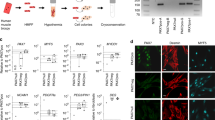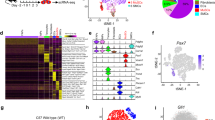Abstract
Differentiation in vitro of striated muscle from apparently non-muscle precursor cells has been reported in thymus reticulum1, a fibroblast-like mouse embryo line2 and in a neuronelike cell line derived from a rat brain tumour3. Also Tomozawa and Sueko reported the differentiation of a peripheral neurotumour clonal stem cell line into separate neuronal and glial cell types4. We report here the reproducible and stable phenotypic change of a well characterised rat glial cell line, B9 (refs 5–7), into multinucleate contractile skeletal muscle. The B9 line was derived from a nitrosoethylurea-induced brain tumour, contains S-100 and 14-3-2 proteins, is electrically non-excitable5 and has a putative glial-specific surface antigen, G2 (ref. 6). It has been phenotypically stable in its laboratory of origin at Salk Institute since 1973. After being transported to the Mayo Clinic in Minnesota the cells began to change from cuboidal to elongate shape, fuse into contractile multinucleate fibres and express nicotinic acetylcholine receptors (AChR) on their plasma membranes. Striated myofibrils appeared in their cytoplasm. The first sign of mesectodermal differentiation in B9 was the transitory appearance on its surface of Thy-1 which, in the rat, is a marker of thymocytes8, certain brain cell lines7, immature skeletal muscle9,10, mammary myoepithelial lines11 and fibro-blasts12. This antigen was not detected in previous studies at Salk Institute7. The inductive influence is not yet known. We propose that transformation of a neurectodermal line into muscle may be evidence of the capacity of mammalian neurectoderm to give rise to skeletal tissues. The concept that skeletal muscle in different anatomical regions might have different embryonic origins could be relevant to the distribution of muscles affected by certain diseases in man.
This is a preview of subscription content, access via your institution
Access options
Subscribe to this journal
Receive 51 print issues and online access
$199.00 per year
only $3.90 per issue
Buy this article
- Purchase on Springer Link
- Instant access to full article PDF
Prices may be subject to local taxes which are calculated during checkout
Similar content being viewed by others
References
Wekerle, H., Paterson, B., Ketelsen, U. P. & Feldman, M. Nature 256, 493–494 (1975).
Constantinides, P. G., Taylor, S. M. & Jones, P. A. Devl Biol. 66, 57–71 (1978).
Brandt, B. L., Kimes, B. W. & Klier, J. G. J. cell Physiol. 88, 255–275 (1976).
Tomozawa, Y. & Sueko, N. Proc. natn. Acad. Sci. U.S.A. 75, 6305–6309 (1978).
Schubert, D. et al. Nature 249, 224–227 (1974).
Stallcup, W. B. Prog. clin. biol. Res. 15, 165–178 (1977).
Lesley, J. F. & Lennon, V. A. Brain Res. 153, 109–120 (1978).
Barclay, A. N., Letarte-Muirhead, M. & Williams, A. F. Biochem. J. 151, 699–706 (1975).
Lesley, J. F. & Lennon, V. A. Nature 268, 163–165 (1977).
Lennon, V. A. & Lesley, J. F. J. Neuropath. exp. Neurol. 37, 649 (1978).
Lennon, V. A., Unger, M. & Dulbecco, R. Proc. natn. Acad. Sci. U.S.A. 75, 6093–6097 (1978).
Stern, P. L. Nature new Biol. 246, 76–78 (1973).
Yaffee, D. Proc. natn. Acad. Sci. U.S.A. 61, 477–483 (1968).
Patrick, J. & Stallcup, W. B. Proc. natn. Acad. Sci. U.S.A. 74, 4689–4692 (1977).
Strauss, A. J. L. et al. Proc. Soc. exp. Biol. Med. 105, 184–191 (1960).
Schubert, D., Carlisle, W. & Look, C. Nature 254, 341–343 (1975).
Katschenko, N. Anat. Anz. 3, 445–467 (1888).
LeLievre, C. S. & LeDouarin, N. M. J. Embryol. exp. Morph. 34, 125–154 (1975).
Goldman, R. L. Am. J. clin. Path. 52, 741–744 (1969).
Levine, G. D. & Rosai, J. Hum. Path. 9, 495–516 (1978).
LeDouarin, N. M., Jotereau, F. V., Houssaint, E. & Belo, M. Ann. Immun. 127, 849–856 (1976).
Lindstrom, J., Lennon, V. A., Seybold, M. E. & Whittingham, S. Ann. N.Y. Acad. Sci. 274, 254–274 (1976).
Lennon, V. A. in Clinical Immunology Update: Reviews for Physicians (ed. Franklin, E.) 259–289 (Elsevier, New York, 1979).
Bargmann, W. in Handbuch des mikroskopischen Anatomie des Menschen vol. 6 (4) (ed. Mollendorff, W. von) 426–428 (Springer, Berlin, 1943).
Freschi, J. E., Parfitt, A. G. & Shain, W. G. J. Physiol., Lond. 293, 1–10 (1979).
Author information
Authors and Affiliations
Rights and permissions
About this article
Cite this article
Lennon, V., Peterson, S. & Schubert, D. Neurectoderm markers retained in phenotypical skeletal muscle cells arising from a glial cell line. Nature 281, 586–588 (1979). https://doi.org/10.1038/281586a0
Received:
Accepted:
Published:
Issue Date:
DOI: https://doi.org/10.1038/281586a0
This article is cited by
-
Migration of myogenic cells in the rat extensor digitorum longus muscle studied with a split autograft model
Cell and Tissue Research (1990)
-
Establishment and characterization of five cell lines derived from human malignant gliomas
Acta Neuropathologica (1987)
-
The correlation of neoplastic vulnerability with central neuroepithelial cytogeny and glioma differentiation
Journal of Neuro-Oncology (1987)
-
Primary rhabdomyosarcoma of brain and cerebellum
Acta Neuropathologica (1985)
-
Clonal heterogeneity of thymic muscle-cell precursors
Bioscience Reports (1984)
Comments
By submitting a comment you agree to abide by our Terms and Community Guidelines. If you find something abusive or that does not comply with our terms or guidelines please flag it as inappropriate.



